Extract from The Guardian

Monday 14 August 2017 04.00 AEST Last modified on Monday 14 August 2017 04.33 AEST
On 15 September 2017 at about 10pm AEST, Nasa’s Cassini spacecraft will plunge deep into the hostile atmosphere of Saturn on an historic but suicidal course. It’s the grand finale of a 20-year mission which has revolutionised our understanding of the solar system and sent home more than a quarter of a million stunning images of Saturn and its moons.
Cassini’s instruments will be running to the last, capturing every possible byte of data from its closest encounter with the ringed planet before it ultimately evaporates.
Some 1.2bn km away, in a valley just outside Canberra, Glen Nagle and his colleagues will be listening intently to what he calls the “whispers” from deep space. “I’m going to be here for 24 hours and I won’t be sleeping,” he says enthusiastically.
Nagle (pictured above) works at the the Canberra Deep Space Communication Complex, aka Tidbinbilla Tracking Station, home to four antennas which help track and command the many spacecraft in our solar system. Run by CSIRO, Australia’s national science agency, but funded by Nasa, Tidbinbilla is one of just three stations in Nasa’s Deep Space Network (the others are in California and Madrid) and it is here that Cassini’s final radio signals will be received and relayed to a global audience.
“We’re going to be responsible for capturing Cassini’s last breath of data,” Nagle says. “It’ll be a bittersweet moment.
“Nasa can’t do it without us because the other stations are completely facing in the wrong direction. Saturn will be in our skies, our field of view. It’s literally the way the planets have aligned.”
Ones and zeros

- National parks and farmers’ fields surround the tracking
station. All photographs by Jonny Weeks
The dishes look surprisingly small from a distance, dwarfed by nature itself, but up close their scale is imposing. The largest is 70m in diameter and 109m across its curvature – “you could throw a football field into it,” Nagle says – and weighs about 4,000 tonnes. They are almost millimetre-perfect parabolic surfaces.
Each dish acts as both a gigantic ear and a gigantic loudspeaker, telling the spacecrafts how to behave, ensuring their health and collecting their data. The dishes operate night and day, whether or not the skies are clear to the naked eye.

- The 70-metre antenna at Canberra Deep Space Communication
Complex
“Spacecraft receive and transmit data as digital ones and zeros. It’s the same way that your phone receives a radio signal before your phone’s software turns it back into a picture, it’s just those ones and zeros. We don’t know whether the stream we’re receiving is a beautiful picture or some instrument data or some engineering data or whatever it is.”
The DSN doesn’t handle satellites in Earth’s orbit – the kind that are used for mobile communications, observation, weather prediction, GPS and so on. “They’re literally too close for us,” Nagle explains. “We just talk to the missions that have headed out across the solar system.”
The furthest of them, Voyager 1, is so far from Earth that it seems a minor miracle its signal can be heard at all. For Nagle, a self-confessed space buff since childhood who is now the outreach and administration lead at Tidbinbilla, it’s a thrilling thought.
“Right now Voyager 1 is roughly 20.7bn km away and moving further away by about 1.4million km every day,” he says. “That’s about four and a quarter times further away than Pluto. So it’s way out there. It takes over 30 hours to get a signal there and back.
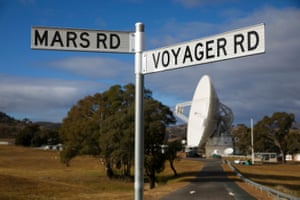
- One of the many road signs memorialising past and present
missions
“And it gets even smaller because as that signal travels across that 20bn km of space it spreads out, it becomes thinner and more diffuse.
“In fact,” he adds excitedly, “the signal we get is equivalent to only about one twenty billionth – billionth with a b! – of the amount of power that’s generated by a typical watch battery. But you’re still getting the information, the ones and zeros, and even though it’s very weak all of the information is still there.”
Up on the dish
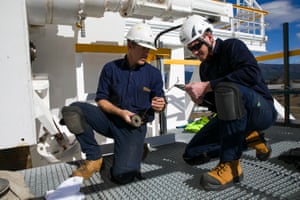
- Michael Murray (right) fixing the gears on DSS35
“Currently we’re inserting a bit of solder to measure the backlash in the gear,” says antenna technician Michael Murray. “We measure the crush on the solder and that’ll give us an idea of what the backlash is.”
As with everything in space exploration, precision counts. And yet, oddly, just a few metres away there’s a kink in the safety rail where a section has been cut away and awkwardly repositioned.
John Howell, the survey electronics technician, laughs. “When they built this antenna they realised the rail was in the way and they had to cut this out [for the dish to be able to fully rotate]. We do months and months of testing when things are first built, we move everything very slowly, and when they got to this bit they realised, ‘Oh no, it’s not going to work.’ We blame the engineers.”
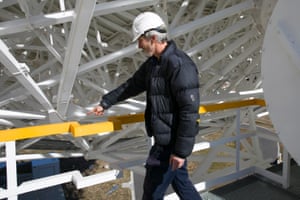
- John Howell, survey electronics technician, pointing out the
mistake in a handrail. It had to be repositioned when the engineers
realised the dish could not rotate fully
“People ask me what are they tracking today and I say, ‘I’ve got no idea.’ As long as my things point to where they’ve got to point ... I mean, when we’ve got a major ‘level one support’ happening like the Mars rovers landing or Cassini then it’s quite interesting, but apart from that some of the scientific stuff is way above my head.”
He adds: “But I am interested in the Voyager probes. It takes forever to get a signal to them and back at the speed of sound” – “light,” Nagle interrupts apologetically – “Oh sorry, the speed of light!” Howell continues.
“They left when I was still in primary school. I find it hard to believe we can talk to something that far away. It blows my mind.”
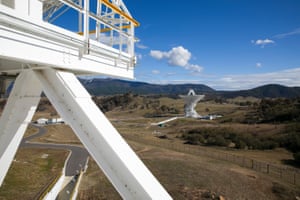
- A view to the north of the station from DSS35
Coiled springs
In the recently built control centre – a place Matthew Purdie, senior link controller, describes as “the heart of the station” – activity is decidedly slow. You might imagine a hive of scientists huddled around monitors awaiting fresh data but in fact there’s only one CSIRO scientist based at Tidbinbilla and his research role is detached from the day-to-day communications performed on behalf of Nasa and the other space superpowers. Nasa’s scientists are located at the Jet Propulsion Laboratory in the US.Purdie and his team of controllers are patiently monitoring banks of screens, waiting for the rare occasion when a command fails or for the more alarming news that a craft has become inoperable or gone missing. Occasionally they have to call the JPL to tell them their craft are sick.
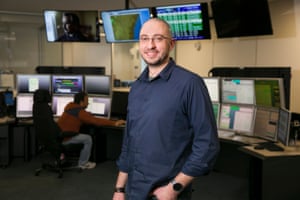
- Matthew Purdie, senior link controller, in the control centre
Behind him, a box of on one of his screens turns orange. “Oh, that’s nothing to worry about,” he says assuredly. “That’s a ‘carrier out of lock’. It’s spacecraft 74. We lost the signal but it was an expected loss of signal because the craft occultated – it went behind Mars.
“Right now I’m on antenna DSS34, so I’m tracking three spacecraft: MRO [Mars Reconnaissance Orbiter], Maven and Mars Odyssey. I’d have to get out the book to tell you exactly what each spacecraft is doing. We know the technical side of our spacecraft, what bit rates they use, command frequencies and all that stuff, but quite often we forget why they’re there.”
Purdie knows plenty about Cassini, however, and has been on duty for some of its recent dives – the series of 22 daring orbits between Saturn and its rings which have given the craft a unique perspective on the planet and the surrounding bands of dust, rock and ice.
Disappointingly, Purdie already knows his shift patterns will cause him to miss the finale next month. He’s tempted to come to work anyway.
“I like being part of history and science,” he says. “I like the fact that I’ve been here for landings and launchings and things like that. Years ago they used to go around to each of the stations and ask for a ‘Go? No go?’, so you’d have to say, ‘DSS45 is a go!’ That was so cool, I loved doing that. They don’t do that any more.”
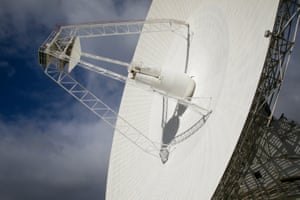
- A close-up view of the largest dish on site showing the
parabolic surface. The tall cone-like structure in the middle is the
transmitter-receiver system. The cone is the height of a five-storey
building
One giant leap
Australia’s involvement in space exploration is six decades old and even though Nagle thinks “Australia doesn’t see itself as a space-faring nation” it has played a critical role in some of the most inspiring moments in the history of humankind.“The dish out the front is the one from Honeysuckle Creek that received and relayed to the whole world the first pictures of Neil Armstrong walking on the moon in 1969,” Nagle explains. He must have regaled people with the full story a thousand times or more, yet he makes it sound anything but tiresome.
“Nasa’s original intention was to use their dish in California to transmit the pictures to the world and show America winning the space race,” he says. “When Neil came out of the spacecraft the first thing he needed to do was switch on a camera which was mounted upside down so that he could later pick it up with his big, gloved hand. Nasa were going to flip the picture but the video technician called in sick that day and his backup forgot.
“Eventually they flipped it but it was highly contrasted because the signal was going to ground somewhere. Mission control couldn’t show that to the world and Neil wasn’t going to wait.”
At the critical moment, Honeysuckle Creek had a perfect image. “When Nasa saw that,” Nagle continues, “they flipped the switch to Australia and 600 million people around the world watched Neil come down the ladder, put his left foot on the surface of the moon and say, ‘One small step for man, one giant leap for mankind.’
“I was an eight-year-old kid sitting in front of the television, glued to the screen, watching humans walk on the moon in glorious black and white. I had no idea that 40 years later I’d be working at the place where I can look out of my window at the dish that brought me those pictures.”
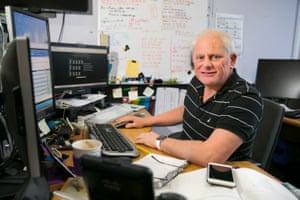
- Greg Boyd, senior network administrator, at his desk at
Canberra Deep Space Communication Complex
“I love the science,” he says. “When I first started I was into everything. We used to have these things called twixes, well before we had emails. They were advisories about what was happening and I’d be reading all this groovy stuff that’s going on.
“As time goes on you become blase. Not jaded; blase. But I’m doing my dream job and I’ve been doing it for the last 25 years. Where else can a boy from Australia work for Nasa and really be critically involved in their missions? This is it.”
Star-spangled sky

- The night’s sky over Tidbinbilla showing the Milky Way
By 3am the clouds have finally dissipated and the vast, star-spangled sky is simply breathtaking. Somewhere out there, Cassini is looping the loop between Saturn and its rings.
In its lifetime Cassini and its accompanying probe, Huygens, have revealed many of the secrets of the Saturnian system: how the particles that make up Saturn’s rings range in size from smaller than a grain of sand to as large as mountains; how Titan, one of the moons, has prebiotic chemistry as well as rain, rivers, lakes and seas; how icy plumes of water are spraying upwards from “tiger stripe” fractures on Enceladus, an otherwise frozen moon.
It has also witnessed giant hurricanes at both of Saturn’s poles and captured the first complete view of the north polar hexagon – not bad for a one megapixel camera. The finale should reveal yet more about the interior of the planet as the craft measures its gravity and magnetic field.
The decision to hurl Cassini into Saturn’s deadly, gaseous atmosphere next month has been made through necessity and responsibility. The craft has run out of fuel and contains a nuclear battery; Nasa’s scientists fear it might contaminate one of the surrounding moons should it crash into them.
“We have to dispose of the spacecraft safely,” says deputy project scientist Scott Edginton, who’s based in California, “because Titan and Enceladus have been shown to be places where there are conditions for habitability, conditions that we think are appropriate for life.
“So our navigators came up with this series of grand finale orbits, flying through the gap between the planet and the rings, and eventually ending in Saturn’s atmosphere. When the scientists saw that plan they were like, ‘Wow, this is unexplored territory, we’re going to learn so many new things.’ So starting April this year we entered into the grand finale orbits. It’s hard to believe we’re almost done.”
Of the final descent, he says: “Think of it as we’re sniffing the atmosphere. It will set the ground truth for past measurements and even future measurements. That’s something I’m really looking forward to.”

- A ‘stacked’ star-trail photograph. Created from 162
individual exposures and made over 81 minutes, it shows the
progression of the stars around the south celestial pole
Life and death
At Tidbinbilla the following morning, the anticipation in the visitors centre is just as palpable. “It’s this generation’s Voyager,” says Jonathan Kent, a self-proclaimed “hack astronomer”. “I think it’s capturing people’s minds and hearts and reinvigorating our interest in space.”Ten-year-old Scout Miller is proof. She’s at the centre with her family, and talk of the discoveries made by Cassini and Juno – Nasa’s mission to Jupiter which delivered a tranche of close-up images of the planet’s red spot – has made her wonder what else might be out there.
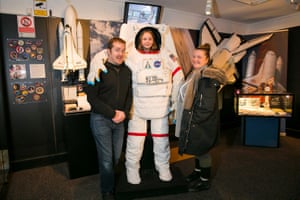
- Scout Miller with her father Jonathon Miller and mother Eva
Johansen in the visitors centre
Many of CSIRO’s staff at Tidbinbilla share her optimism and, even though Nagle forewarns that life may never be found due to the sheer scale and age of the universe, he says: “It would be a fantastic thing to find because it would answer the most fundamental questions we have: Is it just us? Are we alone? Is the universe full of life? Are we the first life? Are we the last?”
Future missions to Saturn and its moons may yet reveal some answers, but for Cassini the deadly denouement is imminent.
“Cassini’s going to end its life as a shooting star in the atmosphere of a giant ringed world,” says Nagle. “There’s no more poetic way for a spacecraft to finish what has been a magnificent mission.”
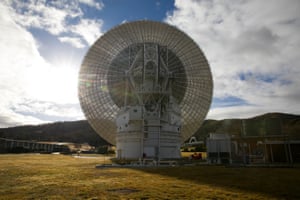
- The rear of DSS43 as the sun rises at the start of a new day
of tracking
No comments:
Post a Comment